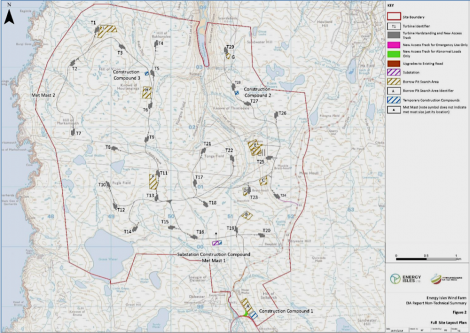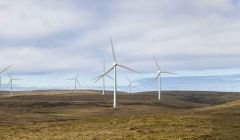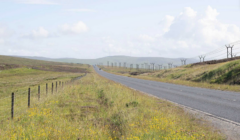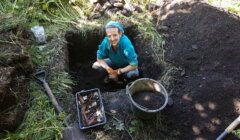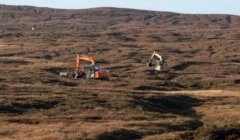Energy / Concerns raised over impact of proposed Yell wind farm
PLANS for a 29-turbine wind farm in Yell have received objections from a number of organisations, including the island’s community council and Shetland Amenity Trust.
Yell Community Council said it objected to current plans for the Energy Isles wind farm, which would be located west of Cullivoe, on the grounds of noise level and environmental and visual impact, as well as the height and number of turbines.
The consortium behind the proposals for the Energy Isles development submitted a planning application to Scottish Government ministers in May.
The overall capacity of the proposed development is in the region of 145 to 200 MW.
As the proposed development is over 50MW in capacity, the decision on whether it gets the green light will come from the Scottish Government’s energy consents unit.
Shetland Amenity Trust said it objected as it believes the location of the wind farm is not suitable for development, mainly due to concerns over the impact on active blanket bog on the site.
Chairwoman Ruth Mackenzie said there was “clear tension” between the Scottish Government’s current policy on renewable energy and the importance it attaches to the role of peatland in tackling global climate change.
“We feel that the construction of industrial-scale wind farms on active blanket bog is incompatible with the government’s national peatland plan,” she wrote.
“It is misleading to suggest, as developers continue to do, that active blanket bog can simply be returned to an active state following the impacts of major development.”
The trust also said the area of Yell “should clearly have been identified” as a wild land area as part of Scottish Natural Heritage’s 2013 consultation on core areas of wild land.
Become a member of Shetland News
“We would urge the government to ask Scottish Natural Heritage to revisit this extensive tract of land on Yell and redress this omission,” it said.
The trust concluded that while it supports “successful’ development of all types of renewable energy, “we consider that it would now be appropriate for the community, led by the council and with the support of the Scottish Government’s energy consents unit, to pause and reflect on all existing and desired consents, and carry out a suitable public consultation exercise that would focus on the impact and consequences for the islands as a whole”.
The amenity trust also warned that if approved then the development should have “independent and properly resourced means” of ensuring that planning conditions to minimise environmental damage are met.
It said that Shetland Islands Council does not have sufficient resources to deal with this at present and “first-hand experience tells us that the developers can take advantage of such situations to cut corners” in the knowledge they are unlikely to be held to account.
Scottish Natural Heritage (SNH), meanwhile, said it believed the current proposal would have “significant adverse effects on the special qualities of the Shetland National Scenic Area such that the objectives of the designation and overall integrity of the area would be compromised”.
The organisation expressed concern over the possible impact on regional populations of breeding birds, particularly the red-throated diver, with SNH keen to see further information.
“We believe that there is scope for a wind farm of smaller scale in the north of Yell and would be happy to work with the developer to find a solution that avoids unacceptable impacts, but the changes necessary to do so are so extensive that this would effectively constitute a new proposal,” SNH added.
Shetland Bird Club said it objected to the plans as the “environmental impact assessment report seriously underestimates the adverse effects of this proposed development on important species and habitat in the area”.
It believes the wind farm would have a “serious adverse effect on the populations of red-throated diver, merlin, golden plover, dunlin, whimbrel, curlew and arctic skua and would severely damage the active blanket bog which is present on much of the site”.
However, the club suggested that if ministers were minded to approve the plans then the habitat management plan should be more extensive.
Outdoor access group ScotWays also objected to the current plans as it believes the “impact on public access has not been fully considered”.
Government agency Scottish Forestry said it would seek reassurance that the small amount of woodland in the area will not be removed.
Tourism body VisitScotland wrote that it would “strongly recommend any potential detrimental impact of the proposed development on tourism – whether visually, environmentally and economically ‐ be identified and considered in full”.
This, it said, would include when taking decisions on turbine height and number.
Marine Scotland said it welcomed that the plans had a proposal to develop a fish species protection plan and site water quality management plan.
Environment body SEPA, meanwhile, suggested a number of conditions be attached to future consent to mitigate the impact of development.
The Energy Isles consortium includes over 50 mainly Shetland-based businesses, from engineering and marine companies to shops and a pub. A full list of members can be found here: https://www.energyisles.co.uk/who
The group says that the proposed development could bring up to £1 million per annum to the North Isles through a community benefit fund over the wind farm’s 30-year lifespan.
It also claims that during the development and construction phase the wind farm would generate up to £25.5 million and 223 ‘job years’ of employment in Shetland.
In May Energy Isles director Derek Jamieson said: “We’ve undertaken a great deal of work over the past fifteen months to make sure we put forward a design that will be both efficient and environmentally acceptable. We believe we have succeeded in our ambition to do this.
“Through conversations with local folk at our public exhibitions in the North Isles last summer and again at the beginning of this year, plus regular meetings with the Community Liaison Group throughout the whole process, we received helpful feedback that played an important part in shaping the final planning application.”
He said that “over the coming decades onshore wind power has a crucial role to play in helping to meet our climate change targets. The Energy Isles Wind Farm will play an important part in supporting this”.
Become a member of Shetland News
Shetland News is asking its many readers to consider paying for membership to get additional features and services: -
- Remove non-local ads;
- Bookmark posts to read later;
- Exclusive curated weekly newsletter;
- Hide membership messages;
- Comments open for discussion.
If you appreciate what we do and feel strongly about impartial local journalism, then please become a member of Shetland News by either making a single payment, or setting up a monthly, quarterly or yearly subscription.






